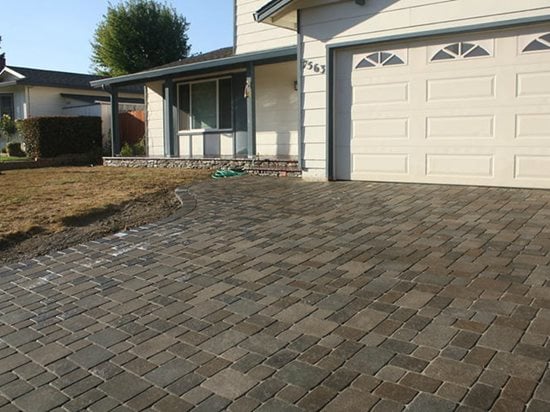- Concrete Paver Information
- Concrete Paver Pictures
- Patio Pavers
- Driveway Pavers
- Pool Deck Pavers
- Sidewalk & Walkway Pavers
- Porous and Permeable Concrete Pavers
- Installing Concrete Pavers
- Pavers Installation: Step-by-step overview of base compaction and mechanical installation
- Pricing of Concrete Pavers
- Paver Thickness & Specifications
- Other Resources
- Find Products: Pavers & Supplies
Driveway Pavers
Design versatility, durability and easy maintenance make concrete pavers a good choice for a drivewayBenefitsConcrete pavers are one of your best choices for a new or replacement driveway if your goals are design versatility, durability and easy maintenance. They are comparable to stamped concrete in terms of design options and durability, with the added advantage of easy, seamless replacement if repairs are ever necessary. A paver driveway can also be driven on immediately after installation, unlike poured-in-place concrete. Concrete pavers come in a wide array of colors, shapes and sizes, permitting you to create design schemes that complement your home’s architecture. What’s more, you can mix and match paver patterns and colors to create striking accent borders and medallions.
“The cost of installing pavers tends to be higher than stamped and colored concrete. However, the long-term value of pavers is realized in their variety of design and color, ease of spot replacement or repair, and resistance to cracking,” says Brian Ramirez owner of BR Landscapers of East Bay, Tracy, Calif.
When installed properly over a well-compacted subbase, pavers will not crack, shift or settle under normal vehicle traffic. Ramirez says that a paver driveway will pay for itself over time, both in lower maintenance costs and longevity. “It will last for decades,” he says. “The bed of aggregate beneath the driveway is strong yet flexible. In addition, the joints between the concrete pavers provide the best of both worlds: strength and flexibility. These driveways will not crack due to freezing or thawing.”
MaintenancePaver driveways require minimum maintenance if they are protected with a good sealer and the joints are filled with a polymer sand, which contains a special polymeric additive that binds and hardens the sand and helps to prevent erosion. “If joints are filled with polymer sand at original installation, the need to refill joint sand in 2 to 3 years is usually eliminated,” says Ramirez. “For the best appearance, you should reapply a sealer every few years.”
To regularly maintain a paver driveway, remove dirt and leaves by sweeping and occasional rinsing. For heavy oil or grease stains, use a pressure washer with an appropriate cleaning solution. Concrete pavers may settle in spots over time if they aren’t installed properly. However, they can easily be reset with no noticeable patchwork. Simply remove the affected pavers, regrade and recompact the subbase, and reinstall the pavers.
In the winter, paver driveways can be plowed or shoveled without dislodgement because they typically have chamfered edges and joints. However, don’t use sharp objects to chop ice, which can damage the pavers. Instead, add traction with sand or apply a noncorrosive deicer, such as calcium magnesium acetate. Avoid the use of sodium chloride (rock salt) and calcium chloride, which can harm the pavers and cause efflorescence.
Buying and installation tips
- To ensure the best performance, use a minimum of 8 to 12 inches of well-compacted base material and a 1-inch sand setting bed when installing paver driveways.
- Use concrete pavers with a minimum compressive strength of 8,000 psi and a maximum water absorption rate of 5%.
- To prevent shifting of concrete pavers, edge restraints anchored by spikes should be installed prior to paver placement.
- The use of darker colored pavers for driveways will help to melt snow faster and hide stains.
- In cold climates, consider installing a snow-melting system beneath the pavers to eliminate snow and ice removal. (See Snow Melting Systems for Concrete Slabs).
Related resources:
Driveway Standards and Design Tips





